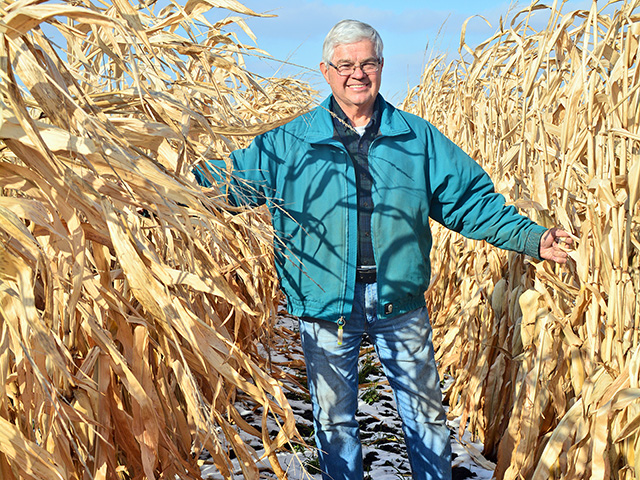Double Duty
Cattlelink - Double Duty
A novel corn-production method may have found a niche with grain and cattle farmers.
But, be warned. Corn grown in 60-inch rows in conjunction with cover crops won't win any yield contests. And, while it may hold its own against traditional 30-inch plantings, weed-control challenges in wide rows can curtail yields.
Those may sound like some serious negatives, but Bob Recker, an independent researcher from Waterloo, Iowa, who's spearheading this wide-row corn movement, says it's going to be the right fit for some producers, especially those who pasture cattle.
"If you just want yield, this concept isn't for you," Recker warns. "But, if you want the value-added pluses cover crops provide like better soil health and extra value from grazing, it can make sense."
Fred Abels sees the advantages. A livestock and grain farmer near New Holland, Iowa, Abels continues to experiment with 60-inch corn and cover crops. He planted 5 acres of the wide rows this spring, intending to compare it to his 30-inch corn. This is his third year looking at the practice. The covers he used those first two years were a mixture of cowpeas and buckwheat.
During Abels' testing, 60-inch rows yielded 7 to 21 bushels per acre less than his 30-inch crop. However, his 60 cow/calf pairs loved grazing out the cover crops and corn stalks after he harvested.
"They search it (cover crops) out and like having legumes on the dinner plate," Abels says. "This can be good if we can get the system worked out."
This year, instead of planting cowpeas and buckwheat, which tend to die after the first frost, he is experimenting with radishes and turnips -- both are hardier. He says the couple of extra weeks of grazing he expects to see will be a big bonus.
EMPHASIZING SOIL HEALTH
Recker, a retired John Deere engineer, started his agronomic research business -- Cedar Valley Innovation -- as a way to give back to farmers who feed him and the world. He's constantly experimenting with row width, seed population and other production methods with volunteer cooperators to economically increase corn production.
P[L1] D[0x0] M[300x250] OOP[F] ADUNIT[] T[]
Recker's research keeps circling back to finding a way for plants to harvest more sunlight, using energy created in the photosynthesis process, to produce bigger, fuller ears.
"The corn-production system is highly mature, but it's tuned to a set of assumptions like uniform plant spacing, canopy and row width," Recker notes. "I looked for a way to make better use of sunlight by a different arrangement in plants."
His research is counter to trends in row widths when it comes to corn. In a quest to increase yields with more plants per acre, corn rows have been getting narrower and narrower. Half of the corn grown in the United States was still planted in row widths of 30.5 inches or more in 1992, according to the U.S. Department of Agriculture (USDA). By 2018, 30-inch rows were the norm in the Corn Belt, with adoption of that practice ranging from 65.6 to 88.7%.
Recker gave 60-inch rows a try in 2017. The idea is corn would be able to absorb more sunlight. He doubled seed population to 68,000 in those wider rows, so he had as many plants as those fields with the 30-inch test strips. He found that without the corn canopy to shade the ground between rows, weed growth became more of an issue. That's where the cover crops come in. They are planted in between the 60-inch corn rows when corn is in the V2 to V6 stage.
In Recker's initial tests, the 60- and 30-inch corn yielded the same -- 230 bushels per acre. The addition of the cover crops added to soil health, helping build organic matter, improving water infiltration, sequestering nutrients and providing a feed source for cattle after the corn is combined.
"Taking care of the soil is a big deal, but the economics have to work," Recker says. "With 60-inch corn rows, farmers have a good shot at doing both."
MORE WORK NEEDED
After some of Recker's initial findings were released, four farmer cooperators with Practical Farmers of Iowa (PFI) tested the concept. So far, those trials reflect some of the same positives Recker found.
Yields can be on par with 30-inch corn in many cases, but weed escapes are problematic. Many producers working with the system have recommended experimenting with 60-inch corn where weed control has not been an issue, as a big weed seed bank can make the approach more challenging.
PFI published research findings last year that showed 60-inch corn had no effect on yield in two trials but reduced yields by as much as 30% in two others. The yields were compared to cooperators' five-year averages.
Recker is not discouraged. "I'm very much in the real world. It's hard for this system to generate a better bottom line and absolute higher yields, which was the goal," he says.
GRAZING VALUE
Putting a pencil to that value will vary with the cattle operation, feed availability and region.
Cover-crop biomass is certainly higher when interseeding into 60-inch corn rows over 30-inch rows. In the PFI studies, 3,776 to 4,225 pounds of biomass were produced per acre, depending on the cover. Those they looked at included mixes of cereal rye, cowpeas, annual rye, buckwheat, guar, mung beans, sunn hemp and rapeseed.
Add to that the value of grazing corn stalks. The Iowa State University (ISU) Beef Center reports each acre of corn stalks grazed can save feeding a half-ton of hay. Abels says grazing in November and December is especially valuable when hay prices are high.
> Follow Matthew Wilde on Twitter @progressivwilde.
FOR MORE INFORMATION:
> Cedar Valley Innovation: www.cedarvalleyinnovation.com
> Iowa Cover Crop Resource Guide: store.extension.iastate.edu/product/14606
[PF_0920]
(c) Copyright 2020 DTN, LLC. All rights reserved.



